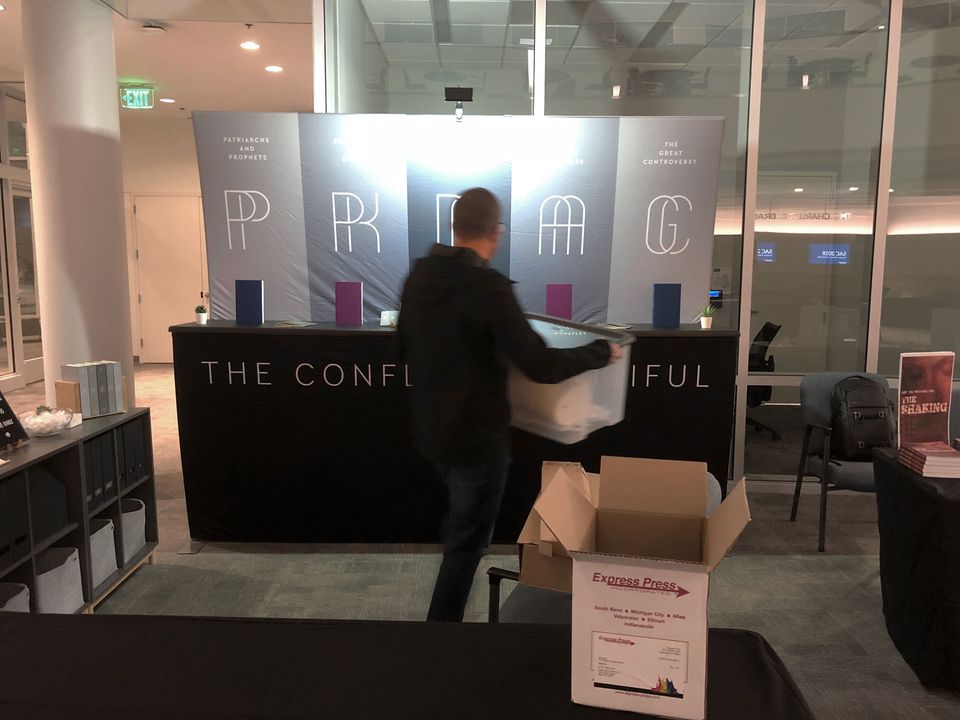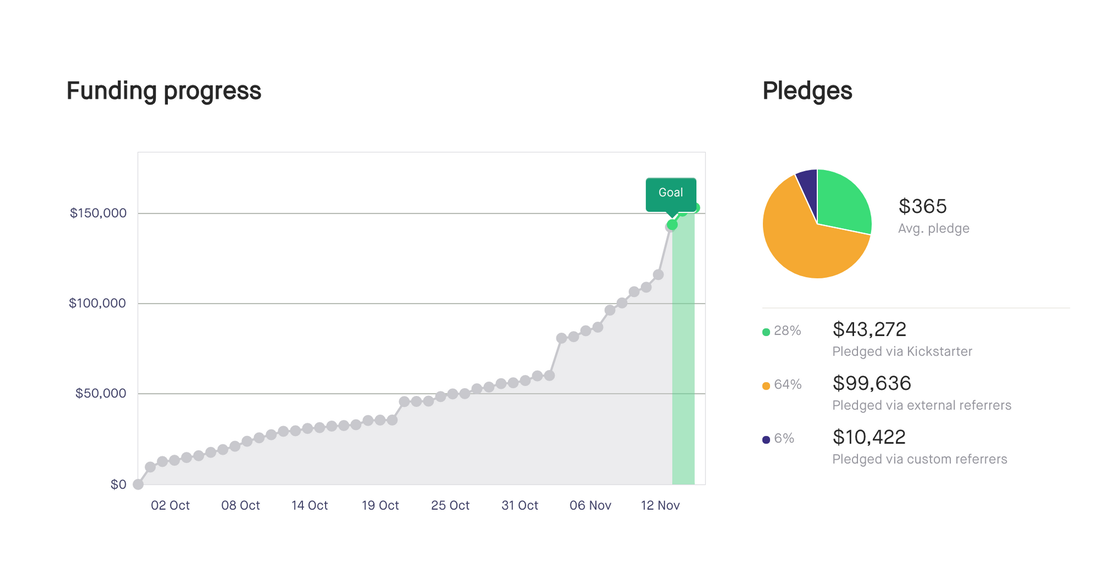Ivan Ruiz-KnottPrincipal and designer for Types & Symbols. The Conflict Beautiful was a crowdfunding project to create a new, heirloom-quality, NKJV edition of Ellen G. White’s Conflict of the Ages series. We reached our $144,000 funding goal on November 15, with a total of $153,330 in pledges, and since then we’ve been managing fulfillment logistics, overseeing editorial changes, refining design details, and working with the printer. It has been a tremendous joy for us to be able to work on this project, and we are humbled that so many people supported it. We’re humbled even further that, in spite of our inexperience with raising money, we were able to meet such a high goal. This was our very first crowdfunding campaign as a studio, and the first time any of us had worked to raise this much money. While we went into it with a strategy and certain amount of preparation, we learned a lot throughout the process that we’d like to share. Our strategy:Our primary strategy was to design something so beautiful and meaningful that it could sell itself. While we didn’t necessarily expect the project to go viral within Adventist circles, we did think it might be possible, and that if the project was worth doing at all, it would be because it was exciting to enough people, and not just ourselves. And by enough people, we mean about 1,000 people. The minimum print run required to get these printed at the quality we wanted was 1,000 sets, and it seemed to us that it was possible that there were at least 1,000 other Adventists who both appreciated these books and appreciated good design. If we could just find that many people willing to order a single set, we would reach our goal. We should note here, for those unfamiliar with Types & Symbols, that we are a design studio dedicated to creating beautiful Adventist experiences for the church and its members. We often work with clients to help them establish brand identities, design websites, design publications, or produce promotional material for marketing campaigns. In most of those cases, we are working with established audiences, or helping fulfill a larger marketing strategy developed by an internal team. We are professional designers, not (yet) marketers, so we had very little direct experience with promoting a project of this scale. With that said, we knew we would need much more than just a beautifully designed project, so before launching the campaign, we got in touch with a number of Adventist leaders to get their input and feedback. We also knew that we needed to launch with some kind of existing base, so we also started to build a mailing list in the months and weeks before launch, through purchasing print and digital ads, and exhibiting at events. In meeting with people, both leaders and lay-people, we heard a tremendous amount of enthusiasm, and it buoyed our hopes that this project might come to life. Finally, once the campaign was live, we knew that we would need to continue building awareness, so we also prepared various design and video materials so that we could maintain a steady stream of promotional posts throughout the campaign. The Conflict Beautiful from Types & Symbols on Vimeo. And then we launched the project. What happened:
Except for the concern around money, we realized that we could have, and still had the opportunity, to provide greater clarity about why this edition was unique, how it wouldn’t exist without pledges made in advance, and how to go through the process of pledging itself. In response to the slowing growth, and some of the reasons we were hearing, we got more more advice and began tweaking our approach. We adjusted our promotional messaging, updated the campaign page for clarity, and added in a few higher level pledge options. And we prayed, a lot. As it turned out, we ended up receiving a significant amount of our pledges from the higher-level pledge amounts, contributed by a small group of very generous individuals. That, paired with an increase in single-set pledges during the final few days, allowed us to reach our goal, and what a relief and encouragement that was! What we learned:1. Crowdfunding is not commonly understood We knew that not everyone would be familiar with Kickstarter, but we had assumed there would be enough familiarity with the concept of crowdfunding. Because of this, we didn’t make a point of clearly explaining how it worked—preferring instead to make posts the focused on the value of the project. After speaking with people, we realized that we certainly should have provided more education about how Kickstarter worked. We spoke with a lot of people who had heard about the project, or seen the video, and quite a few of them said things to the effect of “I’d love to get a set once they’re available!” We would then explain that they might never be available unless people preorder. A lot of our early ads, both print and digital, had been subtle and minimal, with aspirational messaging like “coming soon”, and at the end our messaging started to approach more desperate and overt, like “coming never!—unless you go to Kickstarter and make a pledge/pre-order right now!!!”
2. There is no silver bullet Another thing we learned, or, better stated, was reinforced for us, is that reaching a broad swath of Adventists is very difficult to do. While a number of publications have a wide reach, there are so many things competing for people’s attention, even within the Adventist Church, that it is really easy for people to ignore all of them. We ran print ads, social media ads, exhibited at events, were interviewed for different publications, had other organizations share the project on their own feeds, and in total these were all the different entities that included some mention of the project:
We completed the campaign with 419 backers, with many backers choosing to back more than one set. The total number of sets purchased through Kickstarter was 880. Ultimately though, a significant percentage of our funding was the result of personal connections, and the personal connections of those personal connections. This doesn’t necessarily suggest to us that we should invest less in advertising with the above entities for future projects (multiple exposures are always valuable), but perhaps that we should invest more in developing and cultivating these smaller, more passionate audiences. 3. Building an Audience is key Related to the above, we realized that could have done a better job at building an audience ahead of time. As a studio, we’re not actually very active on social media, and we don’t currently produce much content, so when it came time to reach out to our existing audience of followers, we didn’t really have an audience. In creating this project, we’ve certainly built one. Our mailing list gained nearly 800 subscribers which we’ll be able to reach out to in the future (and helps get us close to 1,000 true fans). We’re also thinking about ways to provide more ongoing value so that, when it comes time to launch another project, there is even more familiarity with our studio, the quality of work that we do, and what we value. 4. Timing matters We realized partway through the campaign that we could have benefitted from launching at a less fraught time. This is more of a suspicion than anything we can measure, but we launched our project around the same time that a lot of concern was starting to be felt in North America (our target market) around conversations at GC Annual Council as well as NAD YEM. The news cycle during this time moved a bit more quickly than it tends to at other times during the year, and we realized that write-ups and links about our project were getting buried pretty quickly. For a marketing campaign that relies on more traditional forms of media, paying attention to the news cycle is important. What we will do differently on the next project:Something we learned from our discussions with people who have engaged in fundraising before is that it is valuable to build in commitments before launching, so that we launch with a certain amount already promised, or ‘in the bucket’. It’s possible that having such a large goal as we did caused some individuals to think that it wasn’t worth pledging because it seemed like such an impossible goal for them to make a difference to. On that note, we arrived at the figure of $144,000 because it was close to what we needed to cover the cost of production, and it seemed like a fun detail, even though it involved rounding down a bit. A lot of people who saw the project also thought it was fun, but we also heard a lot of questions like “but how much do you actually need?”, so in the future we’ll pick less clever numbers, and try to be more explicit about why we need whatever amount we need. Another thing we would do differently for future projects is adjusting how we handle the crowdfunding. Some of the major benefits of Kickstarter (discoverability) don’t matter as much for the nature of the products that we create, or for the audience that we create them for. Furthermore, we discovered after committing to Kickstarter that their options for calculating and handling international shipping were very limited, which in effect reduced the reach of our project. Finally, there were a small number of individuals who’s advice and support had a disproportionate impact on the success of the project, and for our next project we will get them involved much, much sooner. What’s next for Types & Symbols?We have a lot of ideas for future projects, but for the meantime we’re staying focused on finishing up work on The Conflict Beautiful and serving our existing clients. If you didn’t have a chance to back the project, we’re still accepting preorders for the full set at theconflictbeautiful.com.
|
Archives
August 2020
Categories
All
|
- Home
- BLOG
-
RESOURCES
-
RESOURCE MENU
>
- ADVENTIST IDENTITY GUIDELINES
- BIG DATA RESOURCES
- BRANDING, IMAGE & DESIGN RESOURCES
- CHURCH/MINISTRY SPECIFIC RESOURCES
- COPYRIGHT & TRADEMARK BASICS
- COURSES
- EMAIL RESOURCES
- GUIDANCE FOR HIRING SOCIAL MEDIA POSITIONS
- PODCASTS
- REPORTS & CASE STUDIES
- SOCIAL MEDIA RESOURCES
- (SOCIAL) VIDEO RESOURCES >
- TEXTING 4 CHURCHES
- TRACKING & ANALTYICS
- WATCH VIDEOS & TUTORIALS
- WEBSITE TIPS
- SOCIAL MEDIA GUIDELINES
-
RESOURCE MENU
>
- SEO
- Digital Discipleship & Evangelism
- COVID-19 RESOURCES
- eNEWSLETTER






 RSS Feed
RSS Feed